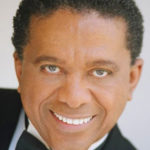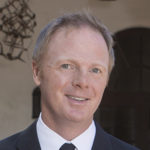
Verdi Requiem May 2009
Sweeping religious music goes operatic : Theme of liberation at the heart of Choral Society’s Requiem performance
May 19 2009
JOSEF WOODARD, NEWS-PRESS CORRESPONDENT
Though immortalized as one of history’s greatest opera composers, in Requiem, Guiseppi Verdi created one of the greatest and most enduring classics of the choral music repertoire, particularly among major 19th century choral works. Even so, as requiems go, Verdi’s has flexible functions.
In fact, the composer had ambivalent religious convictions. He’d begun the major piece more modestly and, thus, brought a freer expressive elan to Mass. In coloring the piece with aspects of his operatic vocabulary, the work transcended the conventions and protocols of standard liturgical music.
Given its backdrop, Verdi’s Requiem appeals to a broad-based audience and lends itself to wide-ranging associations. As grandly presented by the Santa Barbara Choral Society on Saturday night at The Granada, Verdi’s Requiem came equipped with dual dedications.
Officially, the performance commemorated the 65th anniversary of the liberation of the Nazi concentration camp at Terezin (in the Czech Republic), the infamous “model camp” that housed a large population of artists and where Verdi’s Requiem was led 16 times by Raphael Schaechter, before he and his fellow musicians would be killed. Locally and topically, the performance also was dedicated to the heroic efforts of first responders in the recent, ravaging Jesusita Fire, with Sheriff Bill Brown and the American Red Cross’ David Alameda accepting the dedication from The Granada stage.
For this ambitious, 90-minute occasion, the stage was nearly brimming over with the massive aggregation of the Choral Society, the large orchestra and four fine soloists led by the group’s director, Jo Anne Wasserman. It was delivered with a generally impressive, dramatic sweep and focus, marshalling the necessarily elements for achieving the spirit of a grand but personally moving musical event.
Verdi designed his Requiem with the sensibilities of an opera conceptualist, lining the traditional context with dynamic extremes and touches of drama along the way. In the extended Sequence section — a piece in itself — a spatial element is inserted by the placement of the brass in the balcony. A bracingly loud dynamic level drops suddenly to a pianissimo hush, for bass-baritone Michael Gallup’s solo.
Dramatic contrasts prevail throughout the topography of the Mass. In the Offertorio, a showcase for the soloists — also including Santa Barbara-bred tenor Eduardo Villa, soprano Erica Strauss and mezzo-soprano Cynthia Jansen — suddenly zooms in vocal powers in the Sanctus, a thicket-like fugue for the massed choral forces. In the final “Libera Me” section, from whence Verdi’s project started, Ms. Strauss’ solo part leads with awakening abruptness to a most vigorous sonic blast, with all the sound the full chorus and orchestra can muster.
As required by any solid treatment of Verdi’s masterpiece, the Choral Society’s reading lavished both grand gestural ideas and fine points. It can be illuminating and also culturally important to experience this grand work in its uninterrupted entirety — in the heat and magnitude of a strong live performance — to really get at its inherent profundity.
This proved to be a full and diverse Saturday night musical experience, fleetingly spiritual and, at times, downright operatic.

 American baritone, Ralph Cato has travelled the world extensively, telling stories in song with his warm, clarion baritone voice.
American baritone, Ralph Cato has travelled the world extensively, telling stories in song with his warm, clarion baritone voice. Tenor, Benjamin Brecher has performed over fifty operatic roles with many of the world’s most prestigious opera companies, specializing in the high lying lyric tenor repertoire. He has performed 16 roles with New York City Opera alone. Career highlights include performances with Opera Orchestra of New York, L’Opera de Nice, Rossini Opera Festival in Pesaro, L’Opera de Montreal, Santa Fe Opera, Opera Theatre of St. Louis, among many others. His orchestral solo repertoire includes Mozart, Handel, Orff, Bach, Haydn, as well as many performances of Britten. In 2000 he began performing the great Irish Tenor songs in a concert produced for him entitled A Celtic Celebration, Twenty years later, the show has become a North American hit with performances with 45 Symphonies in North America. Ben continues his discography having added his twelfth recording in 2016 Forgotten Liszt, with pianist Robert Koenig, and will record a new release in 2022 entitled “Three Centuries of Thomas Moore” including the music of Britten, Berlioz, and Sarah Gibson on MSR Classics. He is a Professor of Voice at University of California Santa Barbara, where he has served as the Head of Voice.
Tenor, Benjamin Brecher has performed over fifty operatic roles with many of the world’s most prestigious opera companies, specializing in the high lying lyric tenor repertoire. He has performed 16 roles with New York City Opera alone. Career highlights include performances with Opera Orchestra of New York, L’Opera de Nice, Rossini Opera Festival in Pesaro, L’Opera de Montreal, Santa Fe Opera, Opera Theatre of St. Louis, among many others. His orchestral solo repertoire includes Mozart, Handel, Orff, Bach, Haydn, as well as many performances of Britten. In 2000 he began performing the great Irish Tenor songs in a concert produced for him entitled A Celtic Celebration, Twenty years later, the show has become a North American hit with performances with 45 Symphonies in North America. Ben continues his discography having added his twelfth recording in 2016 Forgotten Liszt, with pianist Robert Koenig, and will record a new release in 2022 entitled “Three Centuries of Thomas Moore” including the music of Britten, Berlioz, and Sarah Gibson on MSR Classics. He is a Professor of Voice at University of California Santa Barbara, where he has served as the Head of Voice. Born and raised in Southern California, April Amante is a versatile soprano with expertise and facility in repertoire spanning from early music to contemporary musical theater.
Born and raised in Southern California, April Amante is a versatile soprano with expertise and facility in repertoire spanning from early music to contemporary musical theater. Tracy Van Fleet is pleased to return to the Santa Barbara Choral Society. As a soloist, she has performed with the Los Angeles Master Chorale, Lüneburg Symphony in Germany, Orquesta Filarmónica de Boca del Río in Mexico, Pasadena Symphony, Naples Philharmonic, Los Angeles Bach Festival, San Diego Chamber Orchestra, Colorado Philharmonic, USC Symphony and Chorus, and others. She has had many appearances with the Los Angeles Opera, Los Angeles Philharmonic, Pacific Symphony, Hollywood Bowl Orchestra, Opera Pacific, San Diego Opera and Opera Colorado.
Tracy Van Fleet is pleased to return to the Santa Barbara Choral Society. As a soloist, she has performed with the Los Angeles Master Chorale, Lüneburg Symphony in Germany, Orquesta Filarmónica de Boca del Río in Mexico, Pasadena Symphony, Naples Philharmonic, Los Angeles Bach Festival, San Diego Chamber Orchestra, Colorado Philharmonic, USC Symphony and Chorus, and others. She has had many appearances with the Los Angeles Opera, Los Angeles Philharmonic, Pacific Symphony, Hollywood Bowl Orchestra, Opera Pacific, San Diego Opera and Opera Colorado.